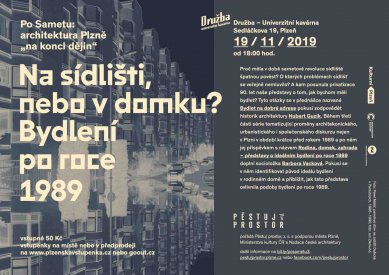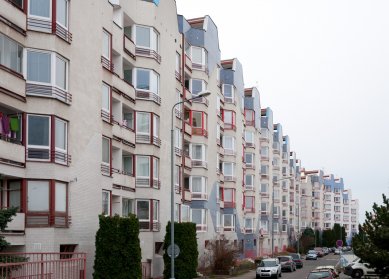
<p>After the Summit: Hubert Guzik and Barbora Vacková</p>
In the housing estate or in a house?
Source
Petr Klíma, Pěstuj prostor, z.s.
Petr Klíma, Pěstuj prostor, z.s.
Publisher
Tisková zpráva
14.11.2019 13:30
Tisková zpráva
14.11.2019 13:30
Czech Republic
Pilsen
On Tuesday, November 19, 2019, the third part of the lecture series After the Velvet Revolution: architecture of Pilsen "at the end of history" will take place in the university café Družba. Architectural historian Hubert Guzik from the Faculty of Architecture of the Czech Technical University in Prague and sociologist Barbora Vacková from Masaryk University in Brno will focus on the topic of housing – especially housing after 1989.
What type of housing did the majority of Czechoslovak citizens prefer during the forty years of so-called real socialism? Why did residential areas have a bad reputation around the time of the Velvet Revolution? Why were we dissatisfied with collective housing? Which issues regarding residential areas were not publicly discussed? And how did the privatization of the 1990s change our ideas about how we should live? “These questions will be addressed in the lecture titled Living at a Good Address by Hubert Guzik,” states Petr Klíma from the organizing association Pěstuj prostor.
Barbora Vacková, in her presentation titled Family, House, Garden. Ideas about Ideal Housing after 1989, will point out that the ideal (family) housing for Czech society has long been a house with a garden in private ownership. In everyday life, such information surprises no one, on the contrary, it is accepted as natural and without significant reservations. However, the family house has not always existed in our society, and private ownership of housing is not a general assumption either. “Barbora Vacková will attempt to identify the origins of this idea of good housing during the lecture and explain how this conception has influenced forms of housing after 1989,” adds Petr Klíma.
The admission fee for the event is 50 CZK. The last part of the lecture series After the Velvet Revolution: architecture of Pilsen "at the end of history" will take place on Wednesday, December 4, 2019, at 6 PM in the building of the regional center of Česká spořitelna at Divadelní 3a in Pilsen. Historian Adéla Gjuričová and architectural historian Jana Pavlová will present lectures dedicated to the post-November transformation, the political-ideological context of the time, and the architecture of banking socialism.
The series is organized by the association Pěstuj prostor with the support of the city of Pilsen, the Ministry of Culture of the Czech Republic, the State Fund for Culture of the Czech Republic, and the Foundation of Czech Architecture. It aims to support and develop the interest of local experts and the general public in architecture and the built and landscape environment of the city.
Mgr. Hubert Guzik, Ph.D. is an architectural historian. From 2006 to 2009, he was the editor of the magazine Stavba, and since 2009, he has been working at the Faculty of Architecture of the Czech Technical University in Prague. In 2014, he published the book Four Paths to Koldom: Collective Housing, Utopia of Czech Architecture 1900–1989, and in 2017, he edited the book Living Together: Collective Houses in the Czech Lands and Europe in the 20th Century. He is currently examining the state of Czech architecture in transitional periods, specifically in 1945–1948 and 1989–1992.
Mgr. Barbora Vacková, Ph.D. is a sociologist working at Masaryk University. She has long been engaged in the topics of urban studies, sociological reflections on the development of modern urbanism, its place in the history of Western modern society, sociology of the city, housing, and home. She is the author of the book Space, Power, and Utopia: The Ideal City and Its Society and co-author of, among others, Home Alone: Housing, Work, and Relationships of People Living in Single-Person Households and Baťa House: Disappearing Elements of Zlín Architecture.
Facebook Event >
What type of housing did the majority of Czechoslovak citizens prefer during the forty years of so-called real socialism? Why did residential areas have a bad reputation around the time of the Velvet Revolution? Why were we dissatisfied with collective housing? Which issues regarding residential areas were not publicly discussed? And how did the privatization of the 1990s change our ideas about how we should live? “These questions will be addressed in the lecture titled Living at a Good Address by Hubert Guzik,” states Petr Klíma from the organizing association Pěstuj prostor.
Barbora Vacková, in her presentation titled Family, House, Garden. Ideas about Ideal Housing after 1989, will point out that the ideal (family) housing for Czech society has long been a house with a garden in private ownership. In everyday life, such information surprises no one, on the contrary, it is accepted as natural and without significant reservations. However, the family house has not always existed in our society, and private ownership of housing is not a general assumption either. “Barbora Vacková will attempt to identify the origins of this idea of good housing during the lecture and explain how this conception has influenced forms of housing after 1989,” adds Petr Klíma.
The admission fee for the event is 50 CZK. The last part of the lecture series After the Velvet Revolution: architecture of Pilsen "at the end of history" will take place on Wednesday, December 4, 2019, at 6 PM in the building of the regional center of Česká spořitelna at Divadelní 3a in Pilsen. Historian Adéla Gjuričová and architectural historian Jana Pavlová will present lectures dedicated to the post-November transformation, the political-ideological context of the time, and the architecture of banking socialism.
The series is organized by the association Pěstuj prostor with the support of the city of Pilsen, the Ministry of Culture of the Czech Republic, the State Fund for Culture of the Czech Republic, and the Foundation of Czech Architecture. It aims to support and develop the interest of local experts and the general public in architecture and the built and landscape environment of the city.
Mgr. Hubert Guzik, Ph.D. is an architectural historian. From 2006 to 2009, he was the editor of the magazine Stavba, and since 2009, he has been working at the Faculty of Architecture of the Czech Technical University in Prague. In 2014, he published the book Four Paths to Koldom: Collective Housing, Utopia of Czech Architecture 1900–1989, and in 2017, he edited the book Living Together: Collective Houses in the Czech Lands and Europe in the 20th Century. He is currently examining the state of Czech architecture in transitional periods, specifically in 1945–1948 and 1989–1992.
Mgr. Barbora Vacková, Ph.D. is a sociologist working at Masaryk University. She has long been engaged in the topics of urban studies, sociological reflections on the development of modern urbanism, its place in the history of Western modern society, sociology of the city, housing, and home. She is the author of the book Space, Power, and Utopia: The Ideal City and Its Society and co-author of, among others, Home Alone: Housing, Work, and Relationships of People Living in Single-Person Households and Baťa House: Disappearing Elements of Zlín Architecture.
Facebook Event >
The English translation is powered by AI tool. Switch to Czech to view the original text source.


0 comments
add comment












